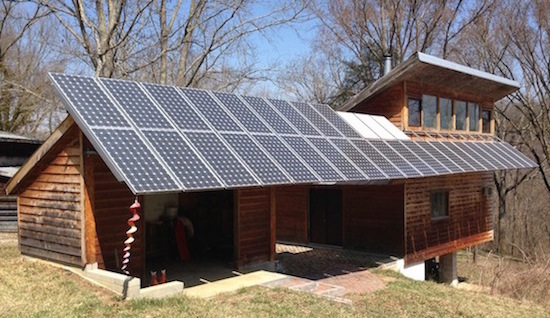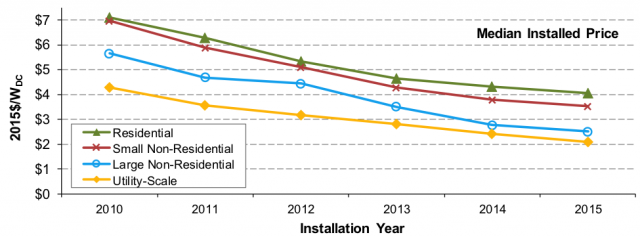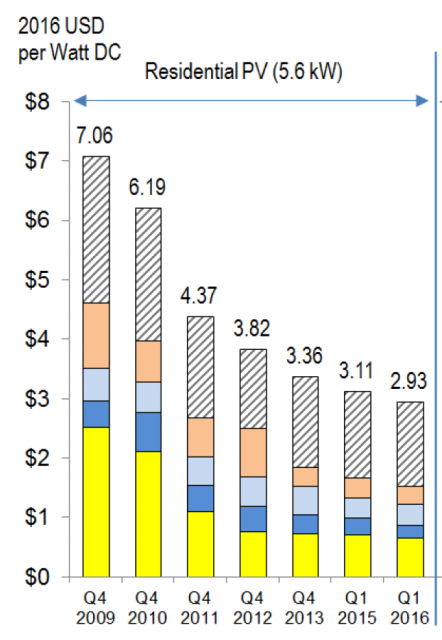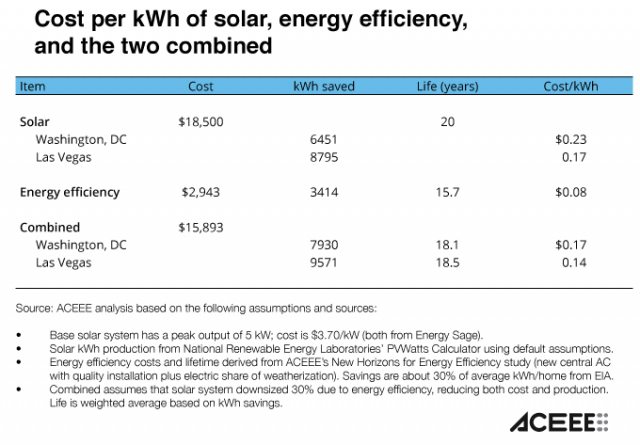
Image Credit: Image #1: Energy Vanguard
Solar energy has sex appeal. If you want to show the world you’re doing something to reduce pollution, you put photovoltaic (PV) panels on your roof to generate clean electricity. Even better, you drive a plug-in hybrid or an all-electric car and charge your car’s batteries with your clean solar electricity.
The good news for solar enthusiasts is the cost of installing a solar electric system on your home just keeps falling and falling. Let’s take a look at some data and then ask if it’s time to abandon energy efficiency.
2 new studies on the cost of solar
In August I saw that Lawrence Berkeley National Laboratory (LBNL) had published a study showing that the cost of solar has fallen to about half of what it was in 2010. The graph below shows the data.
Residential solar, the laggard in the group above, fell from a little over $7 per watt in 2010 to about $4 per watt in 2015. The others all fell to half or less of their 2010 prices.
Two weeks ago I received an email from the National Renewable Energy Lab (NREL) with word of another study on the falling cost of solar. This one, titled U.S. Solar Photovoltaic System Cost Benchmark: Q1 2016 (pdf), includes the first quarter of 2016. The graph at right displays some of the data.
Their report shows the costs for other sectors, too, but here I just posted the graph for residential solar. The LBNL report shows an average of about $4/watt in 2015. The NREL report shows $2.93/watt for the first quarter of this year.
These numbers are great. I’ve been a solar enthusiast for a long time, and I recall the days — not that long ago actually — when everyone was saying, “Solar will really take off when we can get the production up and the cost down.” The number I remember as the threshold was a dollar per watt, but that was just for the PV modules themselves. As you can see above, we hit that mark four years ago in 2012.
You might think it’s time to rush out and buy that solar electric system you’ve always wanted. But…
Is solar our best investment?
Yes, solar electricity is absolutely a good thing. Don’t get me wrong. We need to keep it coming and keep those costs falling. David Roberts wrote at Vox recently, we need electrify everything and clean up our electricity. That’s not a bad idea.
Having said that, I now have to turn your attention to another aspect of cost. The costs noted above are first costs, the cost to install those solar electric systems. Let’s take a look at the cost of producing electricity now.
The American Council for an Energy Efficient Economy (ACEEE) does a lot of great work to promote energy efficiency. In an article titled Solar and Energy Efficiency Need to Work Together, they wrote about a recent analysis they’ve done of the cost per kilowatt-hour (kWh) of solar and efficiency. Here are their main results:
They found that it’s cheaper to save a kilowatt-hour than to generate a kilowatt-hour. But are their numbers realistic? As a former home performance contractor myself, I saw the cost of $2,943 and energy savings of 3,414 kWh and had suspicions. When I looked at the 230 page paper detailing the analysis, I saw that they’re talking about incremental costs. That makes more sense.
You don’t have to buy their numbers if you don’t believe them, though. There are other reasons to support energy efficiency even if it costs more.
Other reasons to do efficiency first
Here’s the thing. The battle between solar and efficiency isn’t a battle at all. They need to be working together. Yes, we need solar energy. But we can’t forget about energy efficiency just because the installed cost of solar has fallen so much. They need to work together.
PHIUS’s Passive House standard does this. After moving away from arbitrary energy reduction targets, the program now has optimized targets for different climates. It doesn’t make sense to keep adding more and more insulation when you’ve gone past the point where it’s more cost-effective to put PV on the roof.
Another problem that’s starting to crop up is this thing called the duck curve. Solar electricity floods the grid in the afternoon and then creates a huge problem in the evening when the traditional generation sources have to ramp up way faster than they’re currently capable. Greater energy efficiency, along with more west-facing PV, can solve that problem.
And there’s one final argument in favor of energy efficiency. Electric utilities are becoming more and more hostile to solar. Net metering and fair prices for your solar-generated electricity are getting harder to find. Have you paid attention to what your utility is doing there?
So, yeah, solar energy has sex appeal. But a comprehensive energy strategy includes lots of energy efficiency, too.
Allison Bailes of Decatur, Georgia, is a speaker, writer, building science consultant, and the author of the Energy Vanguard Blog. Check out his in-depth course, Mastering Building Science at Heatspring Learning Institute, and follow him on Twitter at @EnergyVanguard.
Weekly Newsletter
Get building science and energy efficiency advice, plus special offers, in your inbox.



















15 Comments
Efficiency alone doesn't fix the duck curve.
Higher efficiency lowers the neck & head sure, but it also lowers the belly. The delta is about the same, and the difficult-to-manage ramp rate doesn't change appreciably.
The fix for the duck is smarter load management, which is different from efficiency in the generic sense. With intelligent demand response (in many forms) less time-critical loads such as heating hot water or charging an electric vehicle can happen when there is a power surplus, and reduced or eliminated to lower the ramp rate or absolute peak grid load. Energy storage (short & long term) in batteries, tanks of water, or ice are also load management solutions, are already already economic and available for commercial applications where demand charges are built into the rate structures. Ice storage for air conditioning load management at the residential scale will be available soon, but won't necessarily be economic until/unless utility rate structures offer real-time pricing, or demand charges are applied to residential ratepayers.
http://www.greentechmedia.com/articles/read/ice-energy-will-launch-residential-thermal-storage-in-first-quarter-2017
Alread in the PJM grid region (mid-atlantic, and eastern midwest) hot demand response aggregators will pay $100/year for control of a heting element in a residential hot water heater, turning the large distributed fleet of hot water heaters in to a fast-reacting load, fast enough to be useful for frequency & voltage control for the grid, not just peak & ramp management. It's effectively a "virtual generator", bidding into the ancillary services, capacity and demand-response markets, even though it only generates negawatts rather than megawatts.
So, while these sorts of things make the grid more efficient, lowering the spinning reserves requirements and providing higher throughput/lower line loss, it's not what people are usually talking about when discussing efficiency in the general sense.
Response to Dana Dorsett
Dana, you're right, of course. Energy efficiency isn't the whole solution to the duck curve. Load management and storage are critical. Graham Irwin, a Certified Passive House Consultant in California, has been giving a presentation on the duck curve and puts Passive House in the column with other storage methods like batteries and pumped hydro. I heard him give this talk at the Passive House conference in Philly last month. You can download the slides from when he gave it at the Northwest Passive House conference earlier this year:
http://www.phnw.org/assets/Conference16/presentations/getting%20real%20about%20renewables.pdf
Battery storage has a double-digit cost learning curve too.
I flipped through the slides, but didn't see the argument for how PassiveHouse should be in the same bucket as storage, though it's listed that way on slide #16. (I guess you had to be there?)
What I did notice was that the average CA house hot water is 30% of the total energy use, (slide # 24) which would mean that for a CA PassiveHouse the hot water heating would be more than 50% of the total energy use. Hot water heaters already exceed the power draw of right sized heat pumps (in either heating or cooling mode) even for code min house, so managing the timing of that load relative to the available excess variable renewables capacity does a lot more for the duck curve than converting a building to near zero heating/cooling load with a PassiveHouse. PassiveHouse denizens aren't likely to have a different hot water use pattern than others, but having the fast reacting load and the thermal mass of the water to work with does a lot more for taming the duck than getting rid of or tau-delaying the already more modest heating & cooling peak draws. It's not nothing, but the scale of the benefit is a mouse next to the water-heating elephant on the cited low cooling load days that bring out the worst of the duck.
A worst-offender type of load would be an electric tankless hot water heater, which would be the largest single draw in most homes It is extremely intermittent, and can't be deferred in time the way heating up a tank can. An electric tankless has a high EF due to the near-zero standby loss, but it's the opposite of "green" despite the higher net energy efficiency. It's more efficient, but it's grid-abuse, and can only be rationalized when power pricing is flat, with no demand charges.
I agree with Graham that it's really about the peak power, not the the total energy (slide #5) and that's why the era of cheap battery will be a game-changer at least as significant as the cheap PV era we're entering.
Like PV, battery storage has been seeing precipitous pricing drops too, and that is likely to accelerate as more US states adopt storage mandates, the way CA,OR, and MA have (and now NYC too). Combined with a demand response market the peak grid loads get severely flattened, and it doesn't take a huge amount of storage to get there. Storage is poised to overwhelm the markets currently served by fast ramping peakers, since they have much more flexible sizing and siting constraints, and can be implemented far more quickly than other assets that could fill the bill. When the Aliso Canyon natural gas leak put gas peaking power in jeopardy, the concept of a storage solution first conceived of in May 2016 will in fact be on-line before the end of December 2016.
http://www.utilitydive.com/news/sce-taps-tesla-for-80-mwh-storage-project-to-deal-with-aliso-canyon-gas-sho/426471/
The learning curve of lithium ion battery technology is about a 15%-20% reduction in price with every doubling of capacity, but capacity is doubling roughly annually now, and is likely to accelerate over then next handful of years. The learning curve of rooftop PV is about 20-25% per doubling, with a doubling rate of roughly two years (also accelerating.) The combination is deadly to the traditional utility business models, since by 2025 something like half the homes in the US could get their power more cheaply with on-site PV + batteries than buying centralized power over the grid. (This is already the case in sunnier Australia.)
Part of the drive in battery ramp up is the impending rush to electric vehicles. In at least two European countries internal combustion cars and light trucks will be illegal to sell beginning in 2025, and in the growing market of India that will be the case in 2030. China hasn't set a date for being rid of internal combustion, but is one of the largest EV markets already, and is hoping to own a huge chunk of the international EV market going forward.
Over sufficiently large geography (say , the ERCOT , or PJM grid operator regions) the amount of grid storage necessary for a 100% solar + wind grid without excessive curtailment is shockingly small (even without demand-response), well below what intuition tells us it would be. The study behind the recent MA storage mandate was predicated on an expanding offshore wind and onshore PV replacing most of the baseload power retirements over the next decade, and needs to be able to deliver less than 15% of the peak to completely stabilize the MA grid (which is geographically quite small), and would come at a net savings to the ratepayer. (The mandate that was enacted is for only about 5% of the grid peak, which allows for some sculpting of the policy with changes in what generating assets actually get built.)The sun is always shining (somewhere), and the wind is always blowing (somewhere), and even without increasing grid capacity, widely distributed PV & wind really CAN take it all. As storage costs continue to fall it still has to compete with demand-response, which is cheaper than dirt, but it is already cheaper than peak wholesale power in most US markets, and will be at grid wholesale parity before 2030, assuming the deflationary effect of the tsunami of cheap distributed solar doesn't erode wholesale power pricing dramatically faster than expected.
Talk about counterintuitive!
Perhaps there will soon be a requirement, at least in the more temperate zones of the USA, that all hot water heaters sold have very little thermal insulation. That, along with utility control of their heating elements. In this way the Duck Curve could be more easily flattened under virtually all surplus electricity generating conditions.
Response to Eric Habegger
Eric,
I assume you are being ironic -- although if you are, the punchline escapes me.
If utilities want to remotely control the electric elements in our water heaters, then everyone -- utilities as well as homeowners -- will want water heaters to have thick insulation. Heating water at 3:00 p.m. for a shower at 7:00 a.m. the following morning will only work if tanks are well insulated.
Martin
Well, we ARE talking about remote control of your water heating by an outside agent. Once you go down that path there are endless permutations that can be optimized for doing that. So I wasn't really being ironic. For instance, if your work requires you to get up that early then it would be as simple as interactively requesting thru your computer or by telephone to set it up to start the heating element per that request. I'm merely offering that there will be more flexibility in off loading excess generating capacity if the water heater isn't extremely efficient. That concept seems (to me) to be in accord with some earlier comments.
Response to Eric Habegger
Eric,
For any demand-control program, the advantage to the utility is the opportunity to turn the electric elements off when necessary. Homeowners who have water heaters with thin insulation won't tolerate this interruption of electricity to their water heaters. Homeowners who have water heaters with thick insulation will tolerate it.
I can't conceive of any reason why utilities or homeowners would prefer thin insulation over thick insulation on water heaters.
Well, no expert here but...
It seems like flattening the duck curve will require as much flattening the excess generating capacity during midday as decreasing the load in the morning and evening. If you offset excess generating capacity during the day (because in the near future everyone has loaded up on EV panels) then you need to ramp up that load. This seems like it is actually conceivable if 25 years from now everyone, or nearly everyone, has panels sufficient for peak loads. Where would all those extra watts going during the midday?
There's also the issue everyone wants hot water on demand. So it seems like it might be more important in the future to have a relatively inefficient water heater dissipating energy in the future and then have the utilities turn off the water heater at night. This is where special circumstances could allow you to have them turn them on late at night at an extra demand cost pricing as Dana was advocating.
Net thermal efficiency still matters on that water heater.
Paraphrasing an old Clinton era campaign mantra from the 1990s:
It's the kilowatts, stupid!
A lossy tank has the same sized heating elements and the same thermal mass as an energy efficient tank. The key is to to utilize the thermal mass of the tank to modulate the load, and there is quite a bit of thermal mass overhead between a typical tank storage temp and the maximum temp that the tank can take. The amount of additional total capacity from few hours of standby loss is pretty small spuds- the real deal is the amount peak power that it can dump. The additional amount of time it can sustain that peak before it hit's max temp with a barely insulated tank is really quite small in contrast with the total, and the disadvantage to the homeowner of a high standby loss is high, not worth the paltry additional time. Most homes would use the buffered additional heat in that hot over the course of a day, bringing the water temp down to the regular aquastat's temp (or lower.)
With a demand-response aggregator or utility controlled water heater they can utilize the heating elements at any temperature between your desired minimum storage temp (say, 120-140F) to whatever the maximum temp allowed by the manufacturer (often 200F, even if the heater's aquastat doesn't go that high). A 50 gallon tank has about 420 lbs of water-equivalent thermal mass in it, so raising it even 40F would be a 40F x 420lbs= 16,800 BTU of buffering overhead, or about 5 kwh of power-dump capacity. If your set storage temp is 120F, you'd have potentially ~10kwh of storage dump. Typical cost to the aggregator or utility for installing the controls is on the order of $100, so you're talking under $20/kwh for that capacity. (Concerns about legionella hazard at lower storage temps goes away, since a power dump water heater will be regularly cycled to MUCH higher temperatures multiple times over the course of a given month, killing off colonies before they can become established.)
Multiply that 10kwh capacity by a fleet of 100,000 water heaters and you're talking a megwatt-hour of extremely flexible power buffering capacity, with more than half a megawatt of peak capacity. That's a real negawatt-generator (if not a gigawatt-nuke) and can sink 100% of the output of 1.5kw-2kw of panel for the few mid-day hours that matter, and limit the amount of hot water heater power used during peak hours by those who shower after work or in the early evening, since there will be excess heat in the tank.
Yes, the higher average temperature increases the standby loss, lowering the net efficiency of the water heater. But it's cheap storage (less than $20/kwh), and it's super-fast ramping, with typically 4.5-9 kilowatts of instantaneous power available per tank and in a fleet of 100,000 tanks it adds up to more than a megawatt of ultra-fast ramping load or load-shed, at a capital cost only a tiny fraction of a similar capacity generator (which would also need a load dump that wastes the power to have equivalent speed.) The ability to reduce spinning reserves saves the quite a bit on grid operating & capital costs, as well as total energy use, lowering costs for all ratepayers. Typically payments to the homeowner for the privilege of using it as a power dump exceed the cost of the additional standby losses several fold. Everybody wins.
By contrast, 5-10 kwh of lithium ion grid storage is still more than an order of magnitude more expensive than a hot water heater. Yes, it has more valuable output (peak grid power electricity rather than hot water), but both can be effective in taming the duck. A water heater has more potential for raising the belly than lowering the head, but it's still a very cheap & useful grid moderating tool.
This demand-response aggregator will pay $100/year per water heater to folks in the PJM grid region:
http://mosaicpower.com/
I'm sure there are other aggretators out there operating in PJM's market.
Not all areas have demand response markets as well developed as PJMs, but the ISO-NE grid region is committed to launching an active demand response market beginning June 2018:
https://www.iso-ne.com/markets-operations/markets/demand-resources/about
Dana, I stand corrected
I did not know there was that much reserve capacity for higher heat in a typical water heater. It seems anti-scald devices may become much more important in the future.
Response to Skip Harris
Skip,
The article by Steven Nadel that Allison Bailes references (Solar and Energy Efficiency Need to Work Together) does not base its analysis on the cost of PV + batteries (an off-grid system).
Rather, it bases its analysis on the cost of PV for grid-connected homes (the vast majority of PV systems in the U.S.).
For grid-connected homes equipped with PV systems, the time of day when electricity is used very rarely matters. Only a small percentage of U.S. homes pay for their electricity based on time-of-use billing.
Tempering water is required by code (@ Eric Habegger)
Current plumbing code requires a tempering or mixing valve between the hot water heater and the hot water distribution plumbing feeding all sinks & bathing, but not for hot water piped directly to dishwashers and clothes washers. Most houses are built with only tempered hot water distribution. As I recall code also specifies 140F minimum storage temp (set by the plumber installing the water heater, verified by the inspector) but you can set it to whatever you like.
For a demand-response water heater setting it as low as is tolerable for your needs gives the maximum buffering ability, but even if you keep it at 140F it's still a decent amount of buffering thermal mass.
Heat pump water heaters usually come with at least one resistance element for backup in "hybrid" mode . The GeoSpring has a 4500 watter, which is big enough to be useful for demand-response.
Wi-Fi thermostats (including the Nest) are being used for load time shifting aggregated demand response programs too, eg:
https://nest.com/support/article/What-is-Rush-Hour-Rewards
https://nest.com/support/article/How-does-my-Nest-Thermostat-control-heating-and-cooling-during-an-Energy-Rush-Hour
@ Dana
I wasn't aware of that in code. I know for a fact that my own home, which is at least 70 years old, doesn't have a pre-use mixing valve. This begs the question if one retrofits an older home with an internet connected water heater device for utilities to control it that the water heater is entirely safe for "normal" use. Do you know if that has been factored in?
Does efficiency still matter? Yes, but...
As usual, the answer is complex. The value and cost of power will vary with cost of PV and cost of storage and time of day, so loads that can be run when there is excess power do NOT need to be efficient. These loads (water heating is a good example) don't need to be efficient... so heat pump water heaters are probably a waste of money. Same goes for electric dryers and dishwashers, if one can shift them. On the other hand, lighting is needed exactly when you need it and your costs will not only be based on PV, but on battery cost (an extra $0.10 or $0.30 per kw.hr). Today, LED bulbs will give a far better return than PV+storage!
What about size of the tank?
How does all this affect the size of the hot water tank? OK, more insulation is good, but what about up-sizing the tank, together with super-insulation (fill the cupboard with cellulose?) to provide more storage from the solar panels? I'm not thinking financial advantage so much as being useful in the energy world. One obvious downside would be that if you empty a big tank over a couple of days and there's no sun, then the backup utility power would be on for a longer time. Gets complicated. Any ideas (I'm soon going to be installing two water heaters)?
Log in or create an account to post a comment.
Sign up Log in